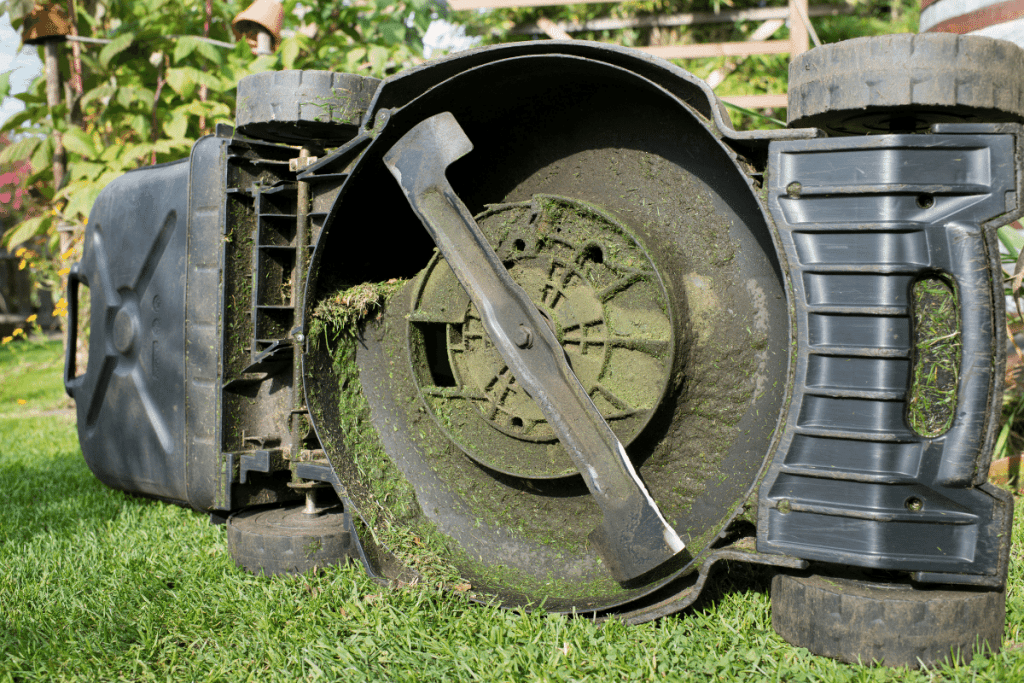There is nothing more discouraging than getting ready to mow your lawn, only to find out your lawn mower keeps dying after you start it.
This is a relatively common problem with lawn mowers, and there are a few easy solutions.
There are several reasons a lawn mower will start then die.
Carburetor issues, leaving old gasoline in the mower, dirty or defective spark plugs, and too much oil in the mower’s reservoir will cause a lawn mower to die shortly after starting. Most problems occur after a long winter in storage to mow the lawn for the first time in the growing season.
Taking a few precautions before storing your lawn mower for the colder months will prevent some of these problems from happening later.
Read on to learn what to do when your lawn mower dies and some helpful tips to remember when storing your mower for the winter.

Table of Contents
Check The Lawn Mower Carburetor
The carburetor is a vital component in a lawn mower because it keeps the engine running smoothly.
A carburetor creates combustion by mixing proper amounts of gasoline and oxygen.
This combustion helps the crankshaft continuously rotate to run the lawn mower’s engine.
A clogged carburetor fuel bowl will not allow enough gas flow to keep the engine running, and it will die shortly after the mower is started.
This problem of a dirty carburetor is easily solved by using a carb cleaner with a pressurized nozzle to remove dirt and sticky residue from the carburetor bowl.
Carb cleaners are very effective and straightforward to use.
Unscrew the carburetor bowl and spray it with carb cleaner, making sure to clean the screw hole as well.
Take care not to over-tighten the screw when reattaching the carburetor bowl, as doing so may strip the threads and break the seal.
To clean small openings in a carburetor, use a nylon cleaning brush in conjunction with the spray cleaner for a more thorough cleaning job.
For regular carburetor maintenance, spray some carb cleaner near the engine’s air intake before starting the mower.
The air intake hole is usually located directly behind the air filter.
Remove the air filter, lightly spray some carburetor cleaner into the intake hole, then replace the air filter.
When you start the lawn mower, the carburetor cleaner will be sucked into the engine, where it will clear any deposits in the carburetor bowl.
There Is Old Gas In The Lawn Mower
One of the most common mistakes in lawn mower maintenance is leaving gas in the mower when storing it for the winter.
Old gasoline will evaporate and leave a sticky fuel residue throughout your mower’s engine.
This residue will clog internal parts and prevent the motor from running.
Fuel with ethanol will also cause corrosion when it is allowed to sit unused.
If the engine is highly clogged, the mower may not even start in the first place.
You will have to siphon out all of the old gas from the lawn mower and replace it with fresh gasoline to fix this problem.
Add a fuel stabilizer to the gas tank to help prevent these residues from forming for up to two years.
Read the instructions on the bottle for the proper fuel to stabilizer ratio for your type of lawn mower.
Without a fuel stabilizer, gas will start to go stale and lose its combustibility within 30 days.
When gas is left in the mower’s tank for more extended periods, such as during the winter months, it will gum up your carburetor and cause issues when starting your lawn mower.
Fuel stabilizer is very inexpensive, usually costing around $10 per bottle, and it will save you a lot of time and money in the long run.
Add a fuel stabilizer to your lawn mower’s tank and allow the engine to run for a few minutes so all of the internal parts are coated.
Doing this every time you plan to store the mower for 30 days or more will help you avoid issues with stale gas.
Fill your mower with fresh gasoline every spring to keep it running at peak efficiency.
Your Lawn Mower Has A Dirty Or Defective Spark Plug

Spark plugs are another component within your lawn mower’s ignition system to check if the mower will not stay running.
One of the most common reasons a lawn mower engine stalls is a faulty spark plug.
The purpose of the spark plugs is to ignite the air and fuel mix in your engine, which creates a small explosion and causes the engine to produce power.
If the spark plugs are dirty or defective, they will not create the necessary spark to start your mower and keep it running.
For most push mowers, the spark plugs are easy to find, and they are usually in the front of your mower, covered in a black cable.
You will need a socket wrench to remove the spark plugs, so check your lawn mower manual for the correct size you need.
You may be able to clean the spark plugs with a wire brush and some fuel injector cleaner if they are not extremely dirty.
Do not use a compressed air cleaner, as this will cause damage to the spark plug.
If the spark plugs are too dirty to clean appropriately or defective, you will have to replace them.
Mowing is critical to a healthy lawn, but you may want to check out our answer to whether frequent mowing thickens grass.
How To Replace The Spark Plugs
Removing the spark plug is more straightforward than replacing one, but the entire job is not difficult overall.
To remove a spark plug, unhook the spark plug wire and use a socket wrench in the correct size to remove the entire plug.
Read your lawn mower’s user manual to learn the recommended size of the gap for your plug, and use a spark plug gauge to measure the gap between the two electrodes at the tip of the plug.
Use the spark plug gauge to adjust the gap in the new plug by bending the curved electrode.
You will know the gap is correct when the gauge has a little bit of drag as you pull it through the plug gap.
Once the gap is set correctly, the spark plug is ready to be installed in your mower.
Take care not to install the plug too tightly, then attach the spark plug lead.
If you have never replaced a spark plug before, ask a more knowledgeable friend for help.
There are plenty of video tutorials online to watch and learn from if no one is available to help you.
As a general rule, only give the spark plug another quarter turn once it starts to feel snugly in place.
Over-tightening the spark plug on installation will damage it, so use special care when doing this step.
Too Much Oil In The Mower’s Reservoir
If your lawn mower’s carburetor and spark plugs are clean and in working order, there may be too much oil in the mower’s reservoir.
When there is too much oil in your mower, white smoke will pour from the engine when you start it, and the mower likely will not stay running for very long.
The reason the lawn mower will not stay running is the oil is drowning out the engine.
Over-filling the oil is straightforward, and it is fixed just as easily by draining some of the oil.
To drain the oil from the mower’s reservoir, you will need to use a siphon.
Alternatively, if you have a push mower, it is possible to tip the lawn mower enough to drain the oil directly from the hole it was poured into.
To prevent overfilling the oil tank in the future, gradually add the oil and use the dipstick to make sure you are filling the tank with the correct amount.
Ensure you have added the correct amount of oil before you use your lawn mower.
Not having enough oil in your mower will create a more severe problem.
You will know the problem is resolved when you start your lawn mower and it stays running without any white smoke pouring from the engine.
More Serious Reasons Your Mower Starts Then Dies

After checking the carburetor, spark plugs, gas tank, and oil reservoir and making any necessary adjustments, your lawn mower should start working again.
If your lawn mower still won’t stay running, or it refuses to start altogether, you may need to call a professional to fix the problem.
If the carburetor does not work after a thorough cleaning, it may simply be worn out.
The only thing left to do with a faulty carburetor is to replace it.
Identifying a faulty choke is another problem that may be difficult to diagnose unless you are mechanically inclined.
A gas tank or gas line blockage is also an advanced issue best left for a professional with more experience in lawn mower repair.
If you do not possess the proper knowledge for repairing your lawn mower, or if you are not comfortable fixing it yourself, it is best to hire someone with the ability to solve the problem.
Start by checking your lawn mower’s warranty, and if it is still covered, the repair will not cost you anything at an authorized repair shop.
Some companies will even send someone to your house to fix your lawn mower, or they will arrange to have it picked up to repair in their shop.
If a manufacturer’s warranty no longer covers your lawn mower, research the reviews on local small-engine repair shops to find the best one in your area.
These small shops typically do not charge a lot for simple repairs.
Check out our article on how early to mow the lawn.
Preventing Lawn Mower Problems
To avoid any problems with your lawn mower, it is essential to take preventative measures when storing it for an extended period, such as during the winter season.
Several maintenance items are to perform in the spring to keep your mower running at peak efficiency.
Storing Your Lawn Mower During Winter
Whenever you plan to store your mower for longer than 30 days, several issues may arise.
Gas will get stale, the carburetor may become damaged, and the mowing deck may get rusty.
There are several easy and inexpensive things to do to your lawn mower to prevent these problems from occurring.
Clean Your Lawn Mower
Start by cleaning the lawn mower, including the undercarriage.
Use a stiff brush to clear away dirt or other organic material, then spray the mower with water.
Once all of the dirt has been removed, take the time to dry the mower with a soft towel. Any water left on the mower may cause rust to form.
Drain The Gas Out
To prevent the carburetor from getting dirty and gumming up, it is best to drain all of the gas out of the mower before putting it away for the season.
Gas will start to break down after 30 days, and it will eventually evaporate from the tank.
When the gas evaporates, it leaves behind a sticky residue, which is harmful to the engine and clog the fuel lines and the fuel filter.
A gas stabilizer may also be added to the fuel tank, effective when used correctly.
You will need to briefly start the mower to run the stabilizer through all of the motor’s moving parts to protect them.
Check the fuel level to ensure you are adding the proper amount of fuel stabilizer.
Remove The Spark Plug
Remove the spark plug and install a new one in the spring.
Save the old spark plug for a backup, and use a spark plug socket to protect the spark plug casing on the mower.
It is also wise to remove the spark plug before cleaning the lawn mower blade to prevent the mower from accidentally starting.
Clean (And Sharpen) The Lawn Mower Blades
Wear protective gloves and undo the bolts underneath the blades to remove them for cleaning.
Use a permanent marker to label the top and bottom of the blades to prevent any confusion during reinstallation.
Once the mower blades are clean, take the time to sharpen them as well.
If you are not comfortable sharpening the blades yourself, take them to a hardware store to have them sharpened for you.
Sharpening the mower blades before they are stored for the winter means you will have one less thing to do to prepare your mower for the spring.
Remove The Battery (If Your Lawn Mower Has One)
To preserve the life of your lawn mower’s battery, it is best to remove it during the winter and store it in a safe place.
Every few weeks, run the battery to ensure it will still hold a charge.
Keep the battery charged to at least 50% to keep the battery from completely dying.
Spring Lawn Mower Maintenance
When it is time to get your lawn mower out of storage, you will need to perform a little maintenance to keep your mower running smoothly.
Check All Removable Parts
Before you use your lawn mower for the first time, check any removable parts.
Even though your mower has been in storage all winter, pieces can become dislodged, significantly if they were already loosened.
Replace The Spark Plug
Since you removed the spark plug before storing the lawn mower for the winter, you will need to replace it with a new plug.
Use the proper spark plug socket to replace the spark plug, and be careful not to overtighten it during installation.
Check The Air Filter
If you live in a dry climate, your mower’s air filter can become dusty and dirty, even while the mower is in storage.
Replace the air filter when dirty to maintain your mower’s fuel efficiency.
A clogged air filter reduces airflow to the engine, causing the air to fuel ratio will become unbalanced.
A sign of reduced airflow is black smoke coming from the exhaust.
Depending on lawn mower usage, you may need to replace the air filter up to twice per year.
Check The Fuel Filter
The fuel filter needs to be serviced or changed once per year to keep your lawn mower running smoothly.
When the fuel filter becomes clogged, it restricts fuel flow to the carburetor and stalls the mower’s engine.
A clean fuel filter provides a steady flow of fuel to the engine to keep it running.
Change The Oil
It is recommended that you change the oil in your lawn mower at least once every other year, but it is best to change it once per year.
Changing the engine oil is not difficult, and it will keep your mower running smoothly.
Sharpen Your Mower Blades
If you did not sharpen your lawn mower’s blades before storing them away for the winter, you need to do it before mowing your lawn for the first time in the spring.
You may either sharpen the blades yourself or have them sharpened at your local hardware store.